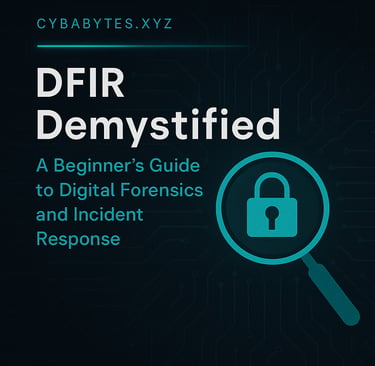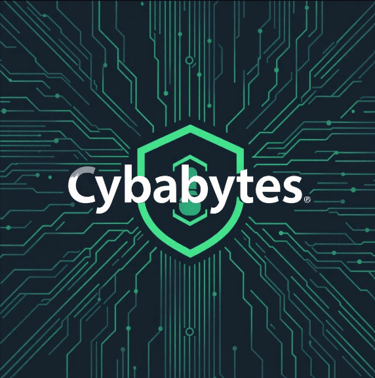What Is DFIR? A Beginner’s Guide
DFIR
7/20/20253 min read


What Is DFIR? A Beginner’s Guide
Introduction
In today’s digital landscape, cyber threats are more complex and frequent than ever. When a security incident occurs, simply recovering is not enough—understanding what happened and preventing it from happening again is crucial. This is where DFIR, or Digital Forensics and Incident Response, comes into play. For anyone considering a career in cybersecurity or seeking to grasp how organizations address breaches, this guide provides a foundation for getting started with DFIR
What Does DFIR Stand For?
DFIR stands for Digital Forensics and Incident Response. It’s a specialized sub-field of cybersecurity that focuses on detecting, containing, investigating, and remediating cyber incidents. DFIR combines two interconnected disciplines:
Digital Forensics: The practice of collecting, preserving, analyzing, and presenting digital evidence. The main aim is to uncover how an attack happened, what systems it affected, and, ultimately, who was behind it.
Incident Response: The structured approach to preparing for, detecting, containing, and recovering from data breaches or cyberattacks. Incident responders act quickly to minimize damage and restore business operations
The Importance of DFIR in Cybersecurity
Thorough Investigation: DFIR uncovers what happened before, during, and after an incident, providing a detailed timeline and identifying the attacker’s actions.
Evidence Preservation: Digital forensic investigations preserve evidence that could be used in legal proceedings or actions against cybercriminals.
Effective Remediation: Insights from DFIR ensure not just symptom removal, but root cause elimination, reducing recurrence risk.
Compliance: Many industries require organizations to follow strict DFIR processes to meet regulatory and cybersecurity standards
How Does DFIR Work? The Core Process
The DFIR process can be broken down into several key steps:
1. Preparation
Establishing policies, incident response plans, and a trained response team ready to act when needed.
2. Identification
Detecting suspicious activity such as abnormal network traffic, compromised accounts, or malware alerts.
3. Containment
Quickly isolating affected systems to prevent further spread of the attack.
4. Collection & Preservation
Gathering digital evidence (“artifacts”) from affected devices, log files, systems, and memory—preserving integrity and maintaining the chain of custody.
5. Analysis
Investigating the evidence to reconstruct the attacker’s tactics, techniques, and procedures (TTPs), and understanding the full scope and impact of the incident.
6. Eradication & Recovery
Removing the attacker’s presence, restoring compromised systems, and returning to normal operations.
7. Lessons Learned
Documenting what happened, how it happened, lessons learned, and updating response plans and defenses to enhance future resilience
Key Tools and Skills in DFIR
Forensic Imaging Tools: Acquire and analyze copies of hard drives and memory (e.g., FTK Imager, Autopsy).
Incident Response Suites: Platforms like TheHive, Cortex, and Velociraptor enable collaborative and efficient response.
Memory Analysis: Tools like Volatility can extract valuable evidence from system memory.
Log Analysis Tools: SIEM solutions (e.g., Splunk, Elastic Stack) for collecting and correlating log data across the environment.
Network Forensics: Tools for deep packet inspection and traffic analysis help spot abnormal behavior.
Essential Skills
Strong understanding of operating systems (Windows, Linux), networking fundamentals, malware analysis, and report writing.
Ability to build detailed attack timelines, preserve evidence, and communicate findings to both technical and non-technical audiences
Who Performs DFIR?
DFIR investigations may be conducted by in-house cybersecurity teams, dedicated Computer Security Incident Response Teams (CSIRT), or external DFIR service providers. Roles on a DFIR team might include:
Digital Forensic Analyst
Incident Responder
Threat Hunter
Malware Analyst
Real-World Applications
Investigating ransomware outbreaks or data theft cases.
Tracing insider threats and employee misconduct.
Responding to advanced persistent threats (APTs) that may span months or years.
Supporting law enforcement actions with digital evidence
How to Start Your DFIR Journey
Learn the Fundamentals: Master basic cybersecurity concepts, operating system internals, and network protocols.
Hands-on Practice: Use free tools in home labs or online CTFs (Capture the Flag), such as TryHackMe or CyberDefenders
Build Your Lab: Set up virtual machines and simulate attacks for practical learning.
Study Real Incidents: Read public incident reports to learn attacker techniques and effective responses.
Keep Learning: Follow DFIR blogs, take online courses, and participate in the cybersecurity community
Conclusion
Digital Forensics and Incident Response is a foundational discipline for modern cybersecurity. DFIR not only helps organizations recover from cyberattacks, but enables them to learn, adapt, and strengthen their defenses against threats. Whether you aspire to a career in cybersecurity or want to understand how attacks are traced and stopped, learning DFIR principles equips you to play an important role in defending the digital world.
